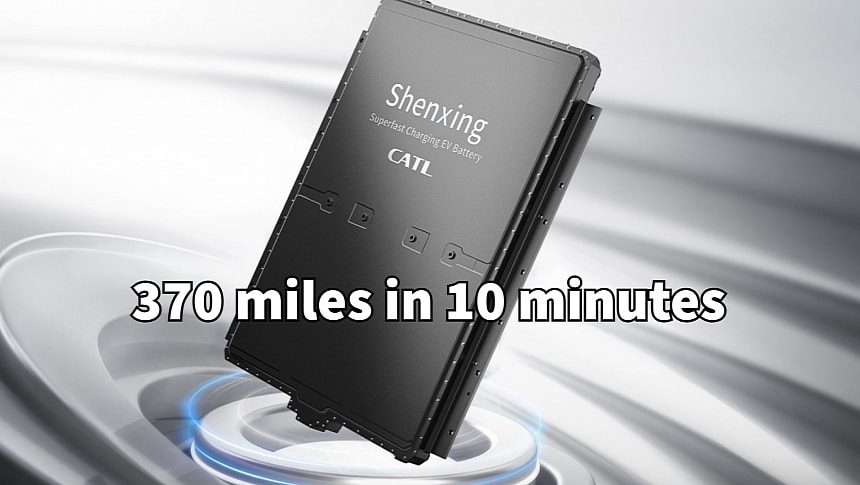CATL is again pushing the boundaries of the LFP chemistry with the Shenxing Plus battery. This LFP battery can add 370 miles of range in 10 minutes of charging. According to CATL, the Shenxing Plus is the world's first LFP battery with 4C ultra-fast charging, and it makes it possible to build electric vehicles with over 620 miles of range according to the Chinese CLTC standard.
Last August, CATL unveiled its Shenxing battery, a superfast charging LFP battery that could enable electric vehicles to travel up to 700 km (435 miles) on a charge. The Shenxing battery was touted as the most advanced lithium-iron-phosphate (LFP) battery capable of 4C ultra-fast charging. Considering that 1C means a full charge in one hour, 4C means it can take a full charge in 15 minutes.
During Auto China 2024, CATL presented an improved version of the Shenxing battery, aptly called Shenxing Plus. This is still capable of 4C charging, but it offers even faster charging, as it can add 600 kilometers (370 miles) of range in 10 minutes of charging. For reference, last year's Shenxing battery could recover 400 km (249 miles) in 10 minutes of charging. The Shenxing Plus battery thus offers similar charging performance as the Qilin battery introduced in 2022, although the latter uses an NMC chemistry.
To make this charging performance possible, CATL used innovative technologies including fast lithium-ion conductive coating, the addition of transition metal elements, and a new nanometer encapsulation. These allowed for smoother and more efficient energy transmission between cathode and anode materials. CATL has also expanded the overcurrent area and capacity of the terminals in the battery system to rapidly dissipate heat during high-current charging.
Regarding BMS core algorithms, CATL's newly developed AI polarization model can predict and control the charging current in real time, enabling faster and smarter energy replenishment. CATL also improved the energy density of its LFP cells, reaching 205 Wh/kg. Surpassing the 200 Wh/kg milestone was possible thanks to a 7% improvement in packing efficiency and more advanced chemistry. LFP packs typically have an energy density between 90 and 160 kWh/kg.
The Shenxing Plus battery pack has an optimized structure on top of the module-free CTP 3.0 technology, making ranges over 1,000 kilometers (620 miles) a reality. CATL also used a granular gradation technology for the cathode, which places every nanometer particle in the optimal position to achieve ultra-high compact density. A proprietary 3D honeycomb-shaped material is added to the anode, boosting the energy density while effectively controlling the volume expansion during charge and discharge cycles. CATL also employed a single-piece casing to optimize internal space utilization, marking an industry-first.
CATL revealed that four car models, including the Xiaomi SU7, use the first-generation Shenxing batteries. By the end of the year, this list will expand to include over 50 models. So far, it's unclear when the Shenxing Plus batteries will make it into a production vehicle.
During Auto China 2024, CATL presented an improved version of the Shenxing battery, aptly called Shenxing Plus. This is still capable of 4C charging, but it offers even faster charging, as it can add 600 kilometers (370 miles) of range in 10 minutes of charging. For reference, last year's Shenxing battery could recover 400 km (249 miles) in 10 minutes of charging. The Shenxing Plus battery thus offers similar charging performance as the Qilin battery introduced in 2022, although the latter uses an NMC chemistry.
To make this charging performance possible, CATL used innovative technologies including fast lithium-ion conductive coating, the addition of transition metal elements, and a new nanometer encapsulation. These allowed for smoother and more efficient energy transmission between cathode and anode materials. CATL has also expanded the overcurrent area and capacity of the terminals in the battery system to rapidly dissipate heat during high-current charging.
Regarding BMS core algorithms, CATL's newly developed AI polarization model can predict and control the charging current in real time, enabling faster and smarter energy replenishment. CATL also improved the energy density of its LFP cells, reaching 205 Wh/kg. Surpassing the 200 Wh/kg milestone was possible thanks to a 7% improvement in packing efficiency and more advanced chemistry. LFP packs typically have an energy density between 90 and 160 kWh/kg.
The Shenxing Plus battery pack has an optimized structure on top of the module-free CTP 3.0 technology, making ranges over 1,000 kilometers (620 miles) a reality. CATL also used a granular gradation technology for the cathode, which places every nanometer particle in the optimal position to achieve ultra-high compact density. A proprietary 3D honeycomb-shaped material is added to the anode, boosting the energy density while effectively controlling the volume expansion during charge and discharge cycles. CATL also employed a single-piece casing to optimize internal space utilization, marking an industry-first.
CATL revealed that four car models, including the Xiaomi SU7, use the first-generation Shenxing batteries. By the end of the year, this list will expand to include over 50 models. So far, it's unclear when the Shenxing Plus batteries will make it into a production vehicle.







